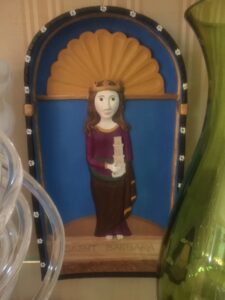 I begin my story of a 20th century two-foot long porcelain plaque of Saint Barbara, owned by JS, with this poem celebrating our city’s patron Saint, written in 1922 by G. K. Chesterton, NOT a resident of our city, but a devout Catholic:
I begin my story of a 20th century two-foot long porcelain plaque of Saint Barbara, owned by JS, with this poem celebrating our city’s patron Saint, written in 1922 by G. K. Chesterton, NOT a resident of our city, but a devout Catholic:
“Barbara the beautiful
Had praise of tongue and pen:
Her hair was like a summer night
Dark and desired of men.
Her feet like birds from far away
That linger and light in doubt;
And her face was like a window
Where a man’s first love looked out.
Her sire was master of many slaves,
A hard man of his hands;
They built a tower about her
In the desolate golden lands,
Sealed as the tyrants sealed their tombs,
Planned with an ancient plan,
And set two windows in the tower
Like the two eyes of a man.”
JS bought this porcelain plaque at the Santa Barbara Mission long ago, at a Parish Craft Show. Barbara holds a tower, referred to in the above snippet of the poem, “The Ballad of Saint Barbara.”
Beloved Saint Since the 7th Century
We here in Santa Barbara see her in carved stone at the apex of the architrave of the Old Mission, standing with the tower and sword. In California we’ve loved her from the Spanish to the Mission era to modern times.
Looking for a valuation of JS’s piece, I see a wonderful bronze figure of Saint Barbara holding a tower and a sword, in front of a wheeled canon, from 1900. The plaque tells, in German, of the presentation of the sculpture to Oberleutant Ruiz of Frankfurt, “scheidenden” (retiring). Emile Hub (1876-1954) made this piece. The clue to this piece, offered at first Dibs for a little over $1,000, is the canon. Ruiz, a German artillery fabricator, received this award.
St Barbara and artillery: a Unique Connection
Barbara is the Patron Saint of gunners and artillerymen. The website of the US Field Artillery Association gives her entire history:
Dioscorus, a Roman Nobleman of Asia Minor of Nicomedia in the 3-4th century AD had a beautiful daughter. He shut her in a tower, fearful of suitors and Christians. Dioscorus commissioned a bathhouse placed in the top of the tower, lit by two windows. He left on a long trip and when he returned, I found Barbara knocked down the walls to create a third window. Some stories say a handsome young Christian priest converted Barbara. A line in the Ballad refers to this, “Where a man’s first love looked out.” Suspecting Barbara honored the Holy trinity, Dioscorus hauled her to a Roman Tribunal, who sentenced her to death for her conversion to Christianity. Her father obliged by torturing and dragging her to a mountaintop where he beheaded her. Mysteriously lightening struck Dioscorus and incinerated him, leaving only his sword.
Barbara became the patroness of those in danger from thunderstorms, fire, explosions, and sudden death. Her feast day is December 4. Our town was named after her because Padre Fermin Lasuen founded the Mission Santa Barbara on St. Barbara’s Day, December 4, 1786. Ironically our city has been often visited by thunderstorms and fire……
How did the myth stand the test of time?
Two hundred years passed after the first shine built to her in Germany. Early in the 9th century authors Ado and Usuard wrote the Symeon Metaphrases, a martyrology including the tales and miracles of Barbara.
In 1448 a new miracle was attributed to Barbara. A fire consumed the home of German Henry Kock. He prayed to Barbara, and managed to get out in time to receive last rites. This solidified Barbara’s position as the patron saint of those in danger by storms, fire, and explosions.
No wonder that in the 13th century Artillerymen and gunners chose Barbara as their patron saint. Early cannon were notorious for blowing up as they were lit! She also became the patron saint of miners.
You will recognize Barbara by her attributes. The tower in her hands or by her side, which bears three windows, the palm frond of martyrdom, and a sword, the same sword used to behead her. She may also hold a chalice and wafer. The value of JS’s charming plaque is $400.